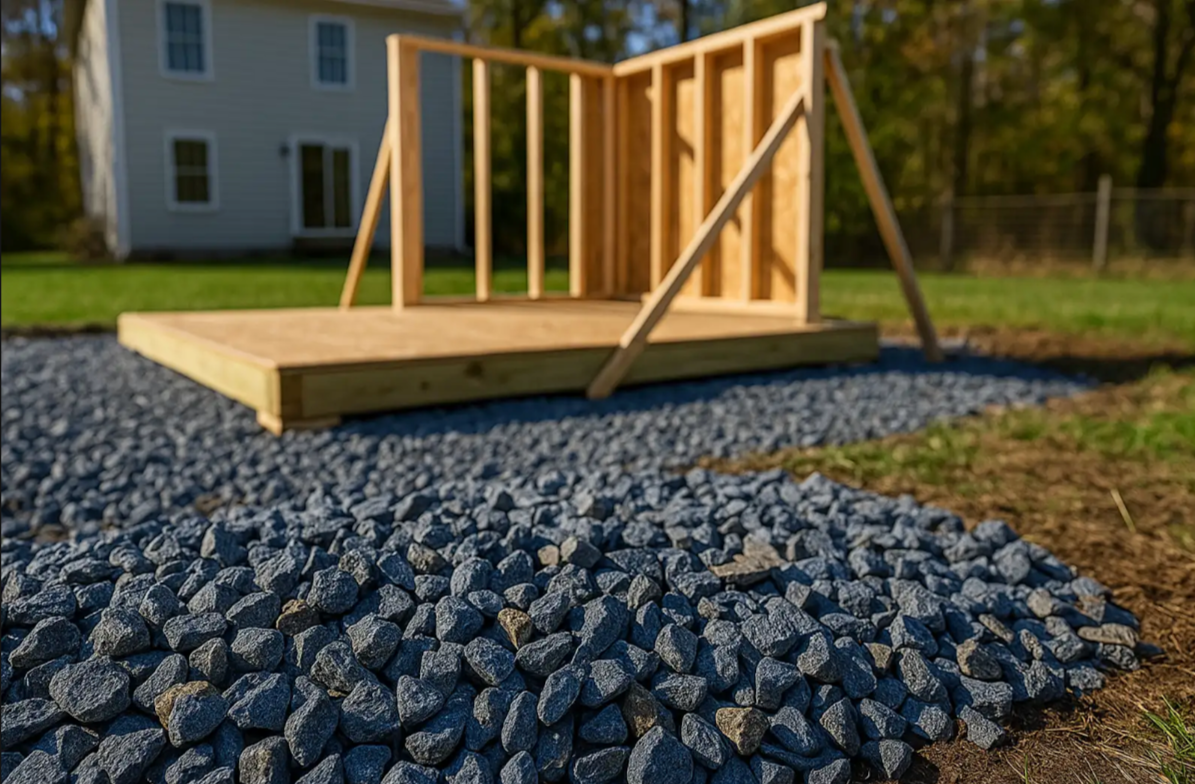
Nobody wants to build the same shed twice! The base material you pick for your shed will affect everything from long-term stability to drainage and longevity, and a poorly built base can lead to shifting, sagging, or rot. But with the right stone and proper preparation, you can create a solid, long-lasting foundation that will keep your shed standing through even the harshest elements.
Save time and money shopping for shed base gravel by shopping with Landscape Barn! Our online experience lets you skip the traffic and haggling. Buy higher quality materials that come quarry direct from a team of experts.
Shop now
Landscape Barn recommends the following stone types for shed bases:
Clean Crushed Stone is the best option for allowing compaction but still providing proper drainage. This material tends to be the go-to choice for most shed foundations.
Stone Dust is often used as a top layer over crushed stone to help with further leveling and compaction, which can be helpful especially if you are working in an area that is not particularly flat..
Crushed stone at this size will work for shed foundations, but is typically more suited to projects where being perfectly level is an absolute requirement (think things like patios, walkways, or anything where tiles are being laid on top).
Before you order material or start digging, you need to take the time to plan out the area for your shed base. Giving your shed room to "breathe" in terms of empty space around the base area has been shown to improve both functionality and aesthetics.
Always extend your base at least 12 inches beyond all sides of the shed. This buffer helps with water runoff, improves structural integrity, and makes it easier to access the shed for maintenance or upgrades.
For most residential sheds, a 4- to 6-inch compacted stone base is sufficient. Larger or heavier structures may need up to 8 inches. This depth includes layering for drainage and support, not just surface stability.
Once you have your dimensions and depth, it is time to determine how much material you will actually need for your foundation. The goal of taking the time to figure out how much material we need (with a buffer amount!) is to make sure we only need to take one trip to the yard.
To calculate the volume you need in cubic yards, use this formula: Length (ft) × Width (ft) × Depth (ft) = cubic feet. You can then divide your total cubic feet by 27 to convert to cubic yards.
Crushed stone weighs roughly 1.3 to 1.5 tons per cubic yard, depending on the moisture of the mix and the type of stone you go with. If you are looking for a safe estimate, multiply the number of cubic yards by 1.4 tons and you will have a rough idea of the weight you can expect.
Here are a few ballpark material estimates for standard sheds using 3/4" crushed stone to help you get an idea of how much stone you might need. What you may notice is that depth is commonly measured in inches, so in order to convert to feet for our volume formula, we divide the depth by 12:

Do it right, do it once. Installing your shed base correctly from the start will save you from future headaches and expensive repairs.
Clear the grass, topsoil, and debris from your entire base area. Dig to the necessary depth and check for levelness. Use a string line or laser level to ensure a uniform cut, and if your yard has drainage issues, consider grading the surrounding area to direct water away from the shed.
Start with a heavy-duty landscape fabric to prevent stone migration into the soil. Spread your crushed stone across the base in 2- to 3-inch layers, compacting each with a plate compactor before adding the next. The final result should be a smooth, level, and firm surface ready for the shed.
Even the best estimates can fall short due to site conditions or settling over time. Planning for a little extra goes a long way.
Stone settles and compacts, especially under load. Ordering an extra 10% ensures you don’t run out mid-project. It’s also helpful for topping off low spots or patching future issues.
Some homeowners try to cut corners, but the consequences can be not only expensive, but even flat out dangerous as time wears on the shed.
Avoid using round or unwashed stones that won't lock together. Also like mentioned above, never skip the compaction step. Loose fill can shift, causing uneven floors or structural damage to your shed that will end with a shed that cannot stand up to the weight of snow or debris landing on top of it.
Building a shed base doesn’t have to be complicated. With the right stone, solid planning, and accurate measurements, you can set your shed on a foundation that lasts for years. If you're ready to get started, contact Landscape Barn today for expert advice and high-quality stone delivered straight to your door.
Take the guesswork out of your next project! Use our Project Calculator to quickly estimate the materials you need for your landscaping plans. Get started here with our Project Calculator.

We’re here to help you bring your outdoor vision to life—reach out with any questions or to start your next project.